Mercury Marquis
| Mercury Marquis | |
|---|---|
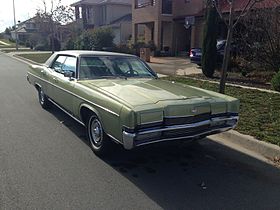 1969 Mercury Marquis 4-door sedan | |
| Overview | |
| Manufacturer | Mercury (Ford) |
| Production | 1967–1986 |
| Body and chassis | |
| Class | Full-size (1967-1982) Mid-size (1983-1986) |
| Chronology | |
| Predecessor | Mercury Montclair Mercury Monterey Mercury Park Lane |
| Successor | Full-size: Mercury Grand Marquis Mid-size: Mercury Sable |
The Mercury Marquis is a model line of automobiles that was marketed by the Mercury division of Ford Motor Company. Deriving its name from a French nobility title, the Marquis was sold across four generations from 1967 to 1986; through its entire production, the model line was the Mercury divisional counterpart of the Ford LTD. Initially introduced as the flagship Mercury range, the Marquis line was later expanded to include the Mercury Grand Marquis slotted above it.
Mercury marketed the first three generations of the Marquis as a full-size coupe, sedan (alongside the Mercury Colony Park station wagon). The fourth generation was a mid-size sedan, as Mercury split the Marquis and Grand Marquis into distinct product lines for 1983. As Ford transitioned its product ranges to front-wheel drive, the Marquis was withdrawn after the 1986 model year, replaced by the Sable (the Mercury counterpart of the Ford Taurus).
For its first three generations, the Marquis was produced in Hapeville, Georgia (Atlanta Assembly), Hazelwood, Missouri (St. Louis Assembly), and Pico Rivera, California (Los Angeles Assembly); the fourth generation was produced by Atlanta Assembly and in Chicago, Illinois (Chicago Assembly).
First generation (1967–1968)[]
| First generation | |
|---|---|
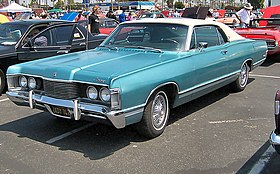 1968 Mercury Marquis | |
| Overview | |
| Production | 1967–1968 |
| Assembly | Hazelwood, Missouri (St. Louis Assembly Plant) Pico Rivera, California (Los Angeles Assembly) Hapeville, Georgia (Atlanta Assembly) |
| Body and chassis | |
| Body style | 2-door hardtop |
| Related |
|
| Powertrain | |
| Engine | |
| Transmission | 3-speed FX/MX automatic (1967) 3-speed FMX automatic (1968) |
| Dimensions | |
| Wheelbase | 123.0 in (3,124 mm) (1967) |
| Length | 218.5 in (5,550 mm) [2] |
| Width | 77.9 in (1,979 mm) |
| Height | 55.1 in (1,400 mm) |

For 1967, Mercury introduced two hardtop model lines above the Park Lane to serve as the counterpart of the Ford LTD. The (Park Lane) Brougham was a four-door, with the Marquis offered solely as a two-door. While all full-size Mercury two-doors were hardtops, the Marquis was fitted with a standard vinyl roof (giving it a wider C-pillar).
While sharing a roofline with the Ford LTD, the Marquis differed from its Ford counterpart from the use of higher-specification interior trim (wood trim in place of simulated wood, optional leather unavailable on the LTD).[3][4] As with other Mercury sedans, the Marquis was built on a 123-inch wheelbase (4 inches longer than the LTD).
In contrast to the full-width bench seat of other Mercury lines, the Marquis was fitted with "Twin Comfort Lounge" front seats. Designed as a 50/50 split bench seat, the design combined the 3-passenger capacity of a bench seat with the individual legroom adjustment of bucket seats.[3] In various forms, the design would gradually replace traditional bench seats in many American cars during the 1970s and 1980s.
Mechanical details[]
For 1967, the standard engine for the Marquis was a 410 cubic-inch Marauder V8, producing 330 hp. Exclusive to the division, the Marauder V8 was optional across the full-size Mercury line.[5] A 4-speed manual transmission was standard, with a 3-speed automatic as an option.[3][5]
For 1968, the 410 was replaced by a 390 cubic-inch Marauder Super 390 V8, producing 315 hp; shared with the Park Lane and Brougham, the engine was optional for lower-trim full-size Mercurys.[6] A 3-speed manual replaced the previous 4-speed, with the automatic returning as an option.[6]
As an option for both years, the 428 cubic-inch Super Marauder V8 was offered, producing 345 hp;[5] for 1968, the engine was retuned to 340 hp.[6]
| First-generation Mercury Marquis powertrain specifications[5][6] | ||||||
|---|---|---|---|---|---|---|
| Engine name
(Engine family) |
Production | Configuration | Fuel system | Output | Transmission | |
| Horsepower | Torque | |||||
| Marauder V8
(Ford FE) |
1967 | 410 cu in (6.7 L) OHV V8 | 4-bbl carburetor | 330 hp (250 kW) | 444 lb⋅ft (602 N⋅m) | 4-speed manual (1967)
3-speed manual (1968) Ford 3-speed FX/MX (Merc-O-Matic) automatic (1967) Ford 3-speed FMX (Merc-O-Matic) automatic (1968) |
| Marauder Super 390 V8
(Ford FE) |
1968 | 390 cu in (6.4 L) OHV V8 | 315 hp (235 kW) | 427 lb⋅ft (579 N⋅m) | ||
| Super Marauder V8
(Ford FE) |
1967-1968 | 428 cu in (7.0 L) OHV V8 | 345 hp (257 kW) (1967)
340 hp (250 kW) (1968) |
462 lb⋅ft (626 N⋅m) | ||
Second generation (1969–1978)[]
| Second generation | |
|---|---|
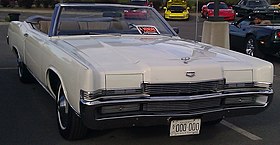 1969 Mercury Marquis convertible | |
| Overview | |
| Also called | Meteor LeMoyne (Canada; 1969-1970) Mercury Marquis Meteor (Canada; 1977–1978) |
| Model years | 1969–1978 |
| Assembly | Hazelwood, Missouri (St. Louis Assembly Plant) Pico Rivera, California (Los Angeles Assembly) Hapeville, Georgia (Atlanta Assembly) |
| Body and chassis | |
| Body style | 2-door hardtop 4-door hardtop 4-door pillared hardtop 2-door convertible 5-door station wagon |
| Related | |
| Powertrain | |
| Engine | |
| Transmission | 3-speed C6 automatic 3-speed FMX automatic |
| Dimensions | |
| Wheelbase | 121.0 in (3,073 mm) (wagon) 124.0 in (3,150 mm) (2-door, 4-door) |
| Length | 229.0 in (5,817 mm) |
| Width | 79.8 in (2,027 mm)[7] 79.6 in (2,022 mm) |
| Curb weight | 4470 lb (2-door) 4508 lb (4-door) |
For 1969, Mercury underwent a revision of its full-size range. Serving as the successor to the Brougham and Park Lane, the second-generation Marquis was expanded to a full range of body styles, slotted above the Monterey. For 1975, the full-size Mercury range was reduced solely to the Marquis (including the Brougham and Grand Marquis trims).
In Canada, the Meteor brand marketed the Marquis as its flagship Meteor LeMoyne from 1969 to 1970. After the 1976 closure of the brand, Ford Canada continued the use of the Meteor name within Mercury, selling a Marquis Meteor as a base trim level for 1977 and 1978.
Chassis specifications[]
The second-generation Mercury Marquis shares its chassis with the full-size Ford model range introduced in 1969, using a rear-wheel drive perimeter frame chassis. Following a tradition starting in 1961, Mercury sedans used a longer wheelbase (124 inches) than Fords (121 inches, also used by Ford/Mercury station wagons). For 1970, the chassis was adopted by the Lincoln division for the Continental on a 127-inch wheelbase.
Carried over from the previous-generation full-size chassis, the suspension was a 3-link live rear axle and double wishbone independent front suspension (with a front stabilizer bar); coil springs were fitted to at all four corners.[8]
Front disc brake and rear drum brakes were standard; power brakes became standard in 1971.[9][10] For 1973, "Sure-Track", an early form of anti-lock braking, was introduced as an option;[11] four-wheel disc brakes became an option for 1975.[12]
Powertrain[]
For the second generation of the Marquis, Mercury revised the powertrain line. Along with ending its Marauder branding for engines, Mercury replaced both the 390 and 428 FE-series engines with a 429-cubic inch 385-series V8. A short-stroke version of the Lincoln 460 V8, the Marquis offered the 429 with 2-barrel and 4-barrel carburetors (320 and 360 hp, respectively).[13] The manual transmission was discontinued, paired solely with the 3-speed Ford C6 heavy-duty automatic. During the 1972 model year, the Marquis received the 460 from Lincoln as an option;[14] for 1974, the 460 replaced the 429 outright.
As the 1970s progressed, Mercury began efforts to improve emissions and fuel economy of its full-size range; following the discontinuation of the Monterey and the introduction of the Grand Marquis, smaller-displacement Ford 335 engines replaced the 460 as the standard engine offering. For 1975,[15] the 402 cubic-inch Ford 400 V8 was introduced (largely as a successor to the 429), with the 351 cubic-inch Ford 351M V8 becoming the standard engine for the Marquis in 1978.[16] In California and for "high-altitude" use, the 400 remained standard equipment; regardless of usage, the 460 (standard on the Marquis Brougham and Grand Marquis through 1977) remained available as an option until the end of the generation.[17] The C6 transmission remained paired to the 460, with the 400 and 351M using the lighter-duty FMX transmission.
| Second-generation Mercury Marquis powertrain specifications | ||||||
|---|---|---|---|---|---|---|
| Engine name
(Engine family) |
Production | Fuel system | Configuration | Output[a] | Transmission | |
| Horsepower | Torque | |||||
| Ford 429 V8 | 1969-1973 | 2-bbl carburetor (1969-1971)
4-bbl carburetor |
429 cu in (7.0 L) OHV V8 | 1969-1971:
(2-bbl) 320 hp (240 kW) (4-bbl) 360 hp (270 kW) 1972: 208 hp (155 kW) 1973: 198 hp (148 kW) |
1969-1971:
(2-bbl) 460 lb⋅ft (620 N⋅m) (4-bbl) 480 lb⋅ft (650 N⋅m) 1972: 322 lb⋅ft (437 N⋅m) 1973: 320 lb⋅ft (430 N⋅m) |
Ford C6 automatic (3-speed) |
| Lincoln 460 V8 | 1972-1978 | 4-bbl carburetor | 460 cu in (7.5 L) OHV V8 | 1972: 224 hp (167 kW)
1973: 202 hp (151 kW) 1974: 198 hp (148 kW) 1975: 218 hp (163 kW) 1976: 202 hp (151 kW) 1977: 197 hp (147 kW) 1978: 202 hp (151 kW) |
1972: 342 lb⋅ft (464 N⋅m)
1973: 330 lb⋅ft (450 N⋅m) 1974: 335 lb⋅ft (454 N⋅m) 1975: 369 lb⋅ft (500 N⋅m) 1976: 352 lb⋅ft (477 N⋅m) 1977: 353 lb⋅ft (479 N⋅m) 1978: 348 lb⋅ft (472 N⋅m) | |
| Ford 400 V8
(Ford 335 series) |
1975-1978 | 2-bbl carburetor | 402 cu in (6.6 L) OHV V8 | 1975: 144 hp (107 kW)
1976: 180 hp (130 kW) 1977: 168 hp (125 kW) 1978: 160 hp (120 kW) |
1975: 255 lb⋅ft (346 N⋅m)
1976: 338 lb⋅ft (458 N⋅m) 1977: 324 lb⋅ft (439 N⋅m) 1978: 319 lb⋅ft (433 N⋅m) |
Ford FMX automatic (3-speed) |
| Ford 351M
(Ford 335 series) |
1978 | 2-bbl carburetor | 351 cu in (5.8 L) OHV V8 | 145 hp (108 kW) | 273 lb⋅ft (370 N⋅m) | |
- ^ Gross output figures for 1969-1971
Body design[]
The second-generation Marquis was expanded from the previous two-door hardtop to a full range of body styles, inheriting the four-door hardtop from the Brougham and four-door sedan and two-door convertible from the Park Lane series. Under the 1969 rebranding of Ford and Mercury station wagons, the Colony Park station wagon became part of the Marquis line.[17]
For 1969 and 1970, the Mercury Marauder made its return, unofficially replacing the S-55. Designed as a competitor for the Oldsmobile Toronado and Buick Riviera, the Marauder was a fastback coupe combining the front bodywork of the Marquis with the roofline of the Ford XL/Ford Galaxie 500 SportsRoof.;[17] along with the Colony Park, the Marauder was built on the 121-inch wheelbase used by Ford.
During its production, the second generation underwent two updates, including a 1971 mid-cycle revision of the exterior and interior. In 1973, to coincide with the addition with 5-mph bumpers, the exterior and interior underwent a complete redesign, with the two-door hardtop receiving a different roofline from the Ford LTD.
1969-1972[]
For 1969, the Mercury full-size range was redesigned (alongside its Ford counterparts); the Marquis remained a counterpart of the Ford LTD model range. Alongside the addition of four-door sedans, the Marquis line gained a station wagon, as the Colony Park woodgrained station wagon was integrated into the model line.
While the Marquis four-door shared much of its roofline with its Ford counterpart, the two-door hardtop was given its own roofline. The front fascia of the Marquis adopted many elements from the Lincoln Continental, including its hood and grille proportions and chrome-topped fenders; the Marquis, LTD/Galaxie/Custom, and Continental each received their own horizontal taillamp design. Initially sharing its hidden headlamps with the LTD, the usage of the design largely became exclusive to Lincoln-Mercury flagships after 1970, including the Marquis, Lincoln Continental, and Mark-series (the LTD Landau became the only Ford to use the configuration). The system was vacuum-operated, closing the headlight covers using a vacuum canister powered by the engine; as a fail-safe. the system was designed to retract the headlight covers following any vacuum loss.[17]
For 1970, the Marquis saw few visible changes to the exterior and interior. In compliance with federal safety regulations, all full-size Mercurys received a new steering column, with a rim-blow steering wheel replacing the previous horn ring design.[18] Alongside the woodgrained Colony Park, a Marquis station wagon (without wood paneling) was introduced.[19]
For 1971, the Marquis underwent a revision of the exterior and interior; the convertible body style was dropped (along with the Marauder fastback). Distinguished by the elimination of vent windows and framed door glass (for sedans and station wagons), Mercury saw the introduction of the "pillared hardtop", a sedan combining a thin B-pillar and frameless door glass (to mimic the appearance of a pillarless design).[20] The revision also included the use of fender skirts and wraparound taillamps. The dashboard underwent a redesign, clustering the instruments and controls closer to the steering wheel.[21]
For 1972, the grille shifted to an egg-crate design (with a similar panel between the taillamps). In line with federal mandates, the Marquis adopted seatbelt warning buzzers.[17][14] For the first time, the model line introduced a power sunroof option (requiring the selection of a vinyl roof).[17][22]
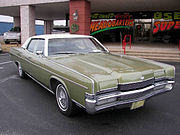
1969 Mercury Marquis sedan

1969 Mercury Marquis sedan (side view)

1970 Mercury Marquis Colony Park station wagon

1971 Mercury Marquis two-door
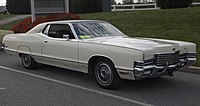
1972 Mercury Marquis Brougham two-door

1972 Mercury Marquis Brougham two-door, rear view
1973-1978[]
For 1973, the Marquis underwent an extensive mid-cycle revision. Largely coinciding with the addition of 5-mph bumpers for the front and rear fascias, the roofline of the Marquis saw a complete redesign.[17] Though distinguished further from the Lincoln Continental, the four-door Marquis shared its roofline with the Ford LTD; in contrast to the LTD, the two-door remained a hardtop with retractable side windows (enlarged for better visibility). Alongside the four-door hardtop, the four-door sedan and station wagon were marketed as "pillared hardtops" (produced with thin chromed B-pillars, allowing frameless door glass). The interior saw a revision of the trim and seats, with a redesign of the dashboard (clustering the instruments behind the steering wheel and the secondary controls to the center of the dashboard[23]).
For 1974, the grille underwent a redesign (nearly matching that of the Lincoln Continental), shifting to a vertically-oriented layout and eliminating the egg-crate trim of the headlamp covers. Following their addition to the front fascia, the Marquis received 5-mph rear bumpers. In response to pending safety regulations, the four-door hardtop was offered for the last time.
For 1975, the front fascia saw several revisions, with a larger radiator-style grille (with the "Mercury" block lettering replaced by a script above the left headlamp); in contrast to the Ford LTD Landau and the Lincoln Continental, the headlamp doors were revised with chrome border trim and a crest emblem. The rear fascia received padded vinyl trim (body color or contrasting) between the taillamps. While Ford and Lincoln added B-pillars (and opera windows) to their two-door sedans, Mercury retained its hardtop roofline.
For 1976 though 1978, the Marquis saw few visible changes; in 1976, a Landau vinyl roof option was introduced for Brougham and Grand Marquis two-doors, while all versions of the Marquis were marketed as "Ride-Engineered"[24] (promoting its successful ride comparisons against more expensive European sedans of the time). For 1978, the Marquis was given a redesigned grille, retaining a similar radiator-style design.
Alongside the 1978 Chrysler New Yorker two-door, the 1978 Mercury Marquis was the final pillarless two-door hardtop (with retractable rear side windows) offered by an American automobile manufacturer.
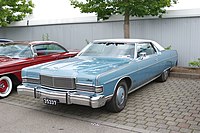
1973 Mercury Marquis 2-door hardtop

1974 Mercury Marquis Brougham 4-door pillared hardtop

1974 Mercury Marquis Brougham 2-door hardtop

1974 Mercury Marquis Brougham, rear view

1978 Mercury Marquis Brougham two-door hardtop

1978 Mercury Marquis Brougham two-door hardtop, side profile
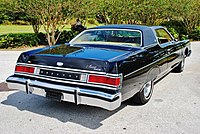
1978 Mercury Marquis Brougham two-door hardtop, rear view
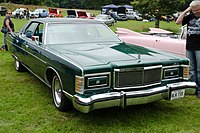
1978 Mercury Marquis Brougham four-door pillared hardtop

1978 Mercury Marquis Brougham four-door pillared hardtop, rear view
Trim[]
In 1969, Mercury adopted the Brougham name from the Park Lane series, continuing its use as the highest Mercury trim line. Following the discontinuation of the Monterey after 1974, all full-size Mercury sedans took on the Marquis nameplate.[17] Introduced as an interior option package for the Marquis Brougham in 1974,[25] the Grand Marquis became a stand-alone trim line above the Brougham for 1975.
From 1969 to 1978, the Colony Park was included as part of the Marquis model range, with Mercury offering a non-woodgrain Marquis station wagon.
Third generation (1979–1982)[]
| Third generation (Panther) | |
|---|---|
 1980 Mercury Marquis 4-door sedan | |
| Overview | |
| Model years | 1979–1982 |
| Assembly | Hazelwood, Missouri (St. Louis Assembly) Hapeville, Georgia (Atlanta Assembly) |
| Body and chassis | |
| Body style | 2-door sedan 4-door sedan 4-door station wagon |
| Platform | Ford Panther platform |
| Related | |
| Powertrain | |
| Engine | 302 cu in (4.9 L) 5.0L Windsor V8 351 cu in (5.8 L) Windsor V8 |
| Transmission | 3-speed C4/SelectShift automatic 4-speed AOD automatic |
| Dimensions | |
| Wheelbase | 114.3 in (2,903 mm) |
| Length | 212.3 in (5,392 mm) (sedan)[26] 217.7 in (5,530 mm) (wagon)[27] |
| Width | |
| Height | |
| Curb weight | 3,635–3,918 lb (1,649–1,777 kg)[26][27] |
For the 1979 model year, the third-generation Marquis was introduced as the full-size Ford and Mercury model lines underwent downsizing. Seventeen inches shorter and over 1,000 pounds lighter than its 1978 predecessor, the 1979 Marquis traded places with the Cougar as the longest Mercury vehicle (prior to its own downsizing for 1980). For the first time since 1955, the full-size Mercury station wagon was produced with a curb weight under 4,000 pounds.
Although the redesign of the Marquis resulted in an exterior footprint smaller than that of the intermediate-segment Mercury Cougar sedan, the Marquis gained interior space over its predecessor through a taller roofline (contributing to improved visibility through increased glass area[28]) and redesigned seats.
For 1983, the full-size Marquis was rebranded as the Grand Marquis; the third-generation Marquis design continued production through the 1991 model year.
Chassis specifications[]
The third-generation Marquis is based upon the rear-wheel drive Ford Panther platform. Developed for the downsizing of the full-size Ford Motor Company product ranges, the architecture is an evolution of the previous-generation chassis (introduced in 1969). For the first time in the history of the division, Mercury shared a common wheelbase with Ford, as both the Marquis and its Ford LTD counterpart adopted a 114.3 inch wheelbase (a 9.7 reduction from the previous 124 inches; 121 inches from Ford and all station wagons). For 1980, the use of the chassis was expanded as Lincoln introduced the downsized Continental and the Continental Mark VI.
The suspension design was revised for the Panther chassis; a double-wishbone independent front suspension returned with a live rear axle, but the 3-link rear suspension was replaced with a 4-link design (coil springs remained for all four wheels).[29] The anti-lock brake and four-wheel disc brake options were dropped, with the Panther platform receiving upgraded front disc brakes; power brakes were standard.[29]
Powertrain[]
The third-generation Marquis marked the introduction of a powertrain lineup completely new to the model line. As a central part of downsizing, the Panther chassis adopted smaller-displacement engines in the interest of fuel economy; in contrast to its Chrysler and General Motors counterparts, a V8 engine remained standard equipment for the Marquis. The 351M, 400, and 460 V8 engines were dropped, with the Marquis now powered by Windsor small-block V8 engines.
As Ford transitioned to metric engine displacement designations at the end of the 1970s, the standard engine for the Marquis was now a 4.9L V8[29] (rounded up to 5.0L, to distinguish it from the 4.9L I6); the rebranded 302 V8 was shared with the Cougar, Monarch, and Zephyr. A 5.8L V8 (the 351 from the Cougar XR7) was offered as an option.[29] For 1980, a 4.2L V8 (a smaller-bore version of the 4.9L engine) became the standard engine on base-trim versions of the Marquis, with the 5.0L V8 shifting to the Brougham and Grand Marquis.[30]
For 1981, a 4.2L V8 was added as the standard engine on base-trim versions of the Marquis, with the 5.0L engine offered on four-door versions of the Marquis Brougham and Grand Marquis.[30] In 1982, the 5.8L V8 was dropped from the Marquis line in the U.S but continued to be offered in Canada.[30][31] In 1979-81 the 351M was offered in Canadian spec cars with the optional heavy-duty towing package only paired to the C6 transmission.[citation needed] When introduced for 1979, both V8 engines were paired with a 3-speed SelectShift automatic. For 1980, the Marquis received the 4-speed AOD overdrive automatic transmission as standard equipment with the 4.2L V8 and was offered as an option with the 5.0L and 5.8L engines. For 1982, the AOD became the sole transmission for all three engines.[31]
| Third-generation Mercury Marquis powertrain specifications | ||||||
|---|---|---|---|---|---|---|
| Engine name
(Engine family) |
Production | Configuration | Fuel system | Output | Transmission | |
| Horsepower | Torque | |||||
| Ford 4.2L V8[32][33]
(Windsor) |
1981-1982 | 4.2 L (255 cu in) OHV V8 | Motorcraft 7200VV 2-barrel carburetor | 120 hp (89 kW) (1981)
122 hp (91 kW) (1982) |
205 lb⋅ft (278 N⋅m) (1981)
209 lb⋅ft (283 N⋅m) (1982) |
Ford 4-speed AOD automatic |
| Ford 5.0L V8[34][35][36][37][38]
(Windsor) |
1979-1982 | 4.9 L (302 cu in) OHV V8 | Motorcraft 7200VV 2-barrel carburetor
Throttle-body fuel injection (1981) |
129 hp (96 kW) (1979)
130 hp (97 kW) (1980-1981) 132 hp (98 kW) (1982) |
223 lb⋅ft (302 N⋅m) (1979)
230 lb⋅ft (310 N⋅m) (1980) 235 lb⋅ft (319 N⋅m) (1981 2-bbl) 230 lb⋅ft (310 N⋅m) (1981 EFI) 236 lb⋅ft (320 N⋅m) (1982) |
Ford 3-speed C4 (SelectShift) automatic
Ford 4-speed AOD automatic |
| Ford 5.8L V8[39][40][41]
(Windsor) |
1979-1981 | 5.8 L (351 cu in) OHV V8 | Motorcraft 7200VV 2-barrel carburetor | 138 hp (103 kW) (1979)
140 hp (100 kW) (1980) 145 hp (108 kW) (1981) |
260 lb⋅ft (350 N⋅m) (1979)
265 lb⋅ft (359 N⋅m) (1980) 270 lb⋅ft (370 N⋅m) (1981) |
Ford 3-speed FMX automatic
Ford 4-speed AOD automatic |
| Ford 5.8L HO V8[42][43]
(Windsor)[a] |
1981-1982 | Motorcraft 7200VV 2-barrel carburetor | 165 hp (123 kW) | 285 lb⋅ft (386 N⋅m) | Ford 4-speed AOD automatic | |
- ^ HO engine used for police-use vehicles only
Body design[]


In conjunction with the downsizing of the model line, the third-generation Marquis and the adoption of the Panther chassis transitioned towards increased parts commonality between Ford and Lincoln-Mercury full-size lines. Along with a common wheelbase (for the first time), the Marquis and the Ford LTD shared nearly their entire bodyshell; many non-visible components were shared with the Lincoln Continental/Town Car and Continental Mark VI. Distinguished primarily by trim, the LTD and Marquis shared a common roofline (the Marquis 4-door is distinguished by a full-length vinyl roof[44]). The two-door hardtop and four-door pillared hardtop were replaced by sedans with fully framed door glass with fixed quarter glass in the rear side doors (each model had its own door design).
While both model lines shared a common bodyshell, several detail changes were made by stylists to distinguish Ford and Mercury full-size sedans from one another. While the LTD received an egg-crate grille design, the Marquis was given a vertically-oriented grille (similar to the 1978 Marquis and the 1980 Cougar XR7) and parking lamps similar to the 1975-1978 Marquis; hidden headlamps were abandoned. In line with the previous generation, the Marquis received full-width taillamps (bordering the license plate). In a feature adopted from the Mark series, the Marquis was styled with (non-functional) fender louvers behind the front wheels (and vents in the front bumper). Ford, Lincoln, and Mercury each received its own dashboard design; Mercury received an instrument panel with square white-face instrument bezels. In 1982, the Marquis introduced a digital trip computer (an option, replacing the analog clock in the dashboard).[30][31]
During its production, the third-generation Marquis saw few major revisions. For 1981, the air vents were removed from the front bumper (and from the fenders in 1982).[31]
Trim[]
The third-generation Marquis carried over its trim nomenclature from the previous generation. Alongside the standard Marquis, Mercury also sold the Marquis Brougham and the top-trim Grand Marquis.[29] Alongside a body-color Marquis station wagon, the woodgrain-trim Colony Park wagon made its return (trimmed as a standard Marquis and as a Grand Marquis[44]). In Canada, the Marquis Meteor continued as the base trim through 1981 (marking the final use of the Meteor nameplate by Ford). From 1981 to 1982, Mercury offered a police-use version of the Marquis, derived from the standard trim four-door sedan.[31][42] Along with its Ford LTD counterpart, police-use versions of the Marquis were fitted with a model-specific speedometer[31] and a 165-hp version of the 5.8L V8.[43]
Fourth generation (1983–1986)[]
| Fourth generation (Fox) | |
|---|---|
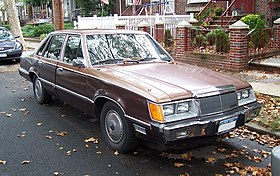 1983-1984 Mercury Marquis 4-door sedan | |
| Overview | |
| Also called | Ford Cougar (Venezuela) |
| Model years | 1983–1986 |
| Assembly | Chicago, Illinois (Chicago Assembly) Hapeville, Georgia (Atlanta Assembly) |
| Body and chassis | |
| Class | Mid-size |
| Body style | 4-door sedan 4-door station wagon |
| Platform | Ford Fox platform |
| Related | Mercury Cougar Ford LTD Ford Thunderbird Lincoln Continental Lincoln Continental Mark VII |
| Powertrain | |
| Engine | 2.3 L (140 cu in) Lima I4 3.3 L (200 cu in) Mileage Maker I6 3.8 L (232 cu in) Essex V6 4.9 L (302 cu in) 5.0L Windsor V8 |
| Transmission | 3-speed C5 automatic 4-speed AOD automatic |
| Dimensions | |
| Wheelbase | 105.6 in (2,682 mm) |
| Length | 196.5 in (4,991 mm) |
| Width | 71.0 in (1,803 mm) |
| Height | 53.8 in (1,367 mm) (sedan) 54.4 in (1,382 mm) (wagon) |
| Curb weight | 3,001 lb (1,361 kg) (sedan) 3,108 lb (1,410 kg) (wagon) |
| Chronology | |
| Predecessor | Mercury Cougar |
| Successor | Mercury Sable |
For 1983, the fourth-generation Marquis was introduced as Mercury shifted the nameplate to the midsize segment to replace the slow-selling Cougar sedan and station wagon. Within Mercury, the Cougar XR-7 was replaced by a redesigned two-door Cougar, with all full-size Mercury sedans adopting the Grand Marquis nameplate.
Effectively downsizing the model range for a second time, the 1983 Marquis shed nearly 9 inches in wheelbase, nearly 16 inches in length, and up to 900 pounds of curb weight (dependent on powertrain and bodystyle).[45] As with previous generations, the fourth-generation Marquis was the Mercury counterpart of the Ford LTD (in 1983, rebranded to replace the Granada).
Coinciding with the design change, production of the model line shifted from St. Louis Assembly to Chicago Assembly (Atlanta Assembly adopted production of the fourth-generation Marquis). Ford Venezuela marketed the Mercury Marquis (under slight trim revisions) as the Ford Cougar from 1983 to 1985.[46]
As Ford transitioned its car platforms to front-wheel drive, the Marquis was discontinued after the 1986 model year, replaced by the Mercury Sable.
Chassis specifications[]
The fourth-generation Marquis is based upon the rear-wheel drive Ford Fox platform. Initially developed for compact sedans, the architecture was expanded for a wide range of Ford and Lincoln-Mercury vehicles; as a multiple-wheelbase design, the Fox platform was introduced for the mid-size segment for 1980. A 105.6 inch wheelbase[45] is shared between the Marquis, Ford LTD, and the Ford Granada/Mercury Cougar. The Fox architecture uses a unibody chassis (in contrast to body-on-frame design used by full-size Ford and Lincoln-Mercury vehicles).
In line with other Fox-platform vehicles, the Marquis uses a front suspension of MacPherson struts with a four-link live rear axle (using coil springs).[45][47] As with the previous generation, the Marquis used front disc brakes with rear drum brakes.[45]
Powertrain[]
The fourth-generation Marquis was produced with four separate engines over its production. Sedans were fitted with a 2.3L inline-4 as standard equipment; a propane-fuel version of the engine was an option.[48] Station wagons were sold only with six-cylinder engines; a 3.3L inline-6 (dating back to the Falcon/Comet) was the standard engine for station wagons and optional on sedans. A 3.8L V6 was optional on both body styles, replacing the inline-6 entirely for 1984. Sold only in Canada from 1984 to 1985, the Marquis LTS was powered by the 5.0L HO V8 (shared with the Mustang).
A 4-speed manual was standard with the 2.3L engine, but was deleted after 1983; subsequent production used the previously optional 3-speed C3 automatic. The 3.3L six was paired solely with a 3-speed C5 automatic. The 3.8L V6 used two different transmissions: the 4-speed AOD automatic was standard for 1983, becoming an option for 1984; the 3-speed C5 became standard for 1984 (replacing the AOD entirely for 1985). All examples with the 5.0L V8 (the LTS) used the 4-speed AOD automatic.
| Fourth-generation Mercury Marquis powertrain specifications | ||||||
|---|---|---|---|---|---|---|
| Engine name
(Engine family) |
Production | Configuration | Fuel system | Output | Transmission | |
| Horsepower | Torque | |||||
| Ford 2.3L OHC[49][50][51]
(Pinto LL23) |
1983-1986 | 2.3 L (140 cu in) SOHC I4 | Carter 1-bbl carburetor | 90 hp (67 kW) (1983)
88 hp (66 kW) (1984-1985) |
122 lb⋅ft (165 N⋅m) | 4-speed manual (1983)
Ford 3-speed C3 automatic |
| Ford Mileage Maker Six[52]
(Falcon Six) |
1983 | 3.3 L (200 cu in) OHV I6 | Holley 1-bbl carburetor | 92 hp (69 kW) | 156 lb⋅ft (212 N⋅m) | Ford 3-speed C5 automatic |
| Ford 3.8L V6[53][54][55]
(Essex V6) |
1983-1986 | 3.8 L (232 cu in) OHV V6 | Ford 2-bbl carburetor
Fuel injection (Throttle-body) |
112 hp (84 kW) (2-bbl)
120 hp (89 kW) (TBI) |
175 lb⋅ft (237 N⋅m) (2-bbl)
205 lb⋅ft (278 N⋅m) (TBI) |
Ford 4-speed AOD automatic (1983-1984)
Ford 3-speed C5 automatic (1984-1986) |
| Ford 5.0L HO V8[56]
(Windsor) |
1984-1985 | 4.9 L (302 cu in) OHV V8 | Fuel injection (Throttle-body) | 165 hp (123 kW) | 245 lb⋅ft (332 N⋅m) | Ford 4-speed AOD automatic |
Body design[]
The fourth-generation Marquis was produced as a four-door sedan and as a five-door station wagon (the two-door was discontinued, with the Cougar becoming the sole Mercury mid-size coupe. Sharing its entire bodyshell with its Ford LTD, the Marquis was distinguished by its own grille, taillamps, and parking lamp lenses. For the 1985 model year, the Marquis underwent a minor exterior revision; along with revised taillamps, Mercury lettering in the grille was replaced with a centered crest emblem.
The interior of the Marquis and LTD was largely shared between the two model lines (with the exception of the interior door panels). To save development costs, the Marquis retained the dashboard design of the Cougar XR-7 coupe (mixing wood and silver trim), adopting its electronic instrument panel option.[57] Adopted from the full-size Marquis and the Cougar XR-7, the Marquis continued the use of an electronic trip computer.[57]
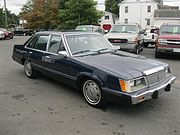
1985 Mercury Marquis Brougham

1985 Mercury Marquis Brougham, rear view
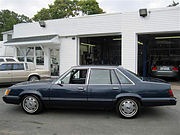
1985 Mercury Marquis Brougham, side profile

1984 Mercury Marquis station wagon, rear view
Trim[]
The fourth-generation Marquis sedan was produced in two trim levels: the base Marquis and the Marquis Brougham. The station wagon was not available under the Brougham trim level; a woodgrain exterior trim option was offered (dropping the Villager trim name).
During the 1984 model year, the Marquis LTS was introduced. Sold only in Canada, the LTS was a counterpart of the Ford LTD LX. Powered by 165 hp 5.0L V8, the LTS and LX adopted suspension and brake components from the police-package version of the LTD. After the 1985 model year, the trim was discontinued; only 134 were produced (making it one of the rarest vehicles ever sold by Mercury).
Discontinuation[]
For the 1986 model year, Mercury introduced the front-wheel drive Mercury Sable, replacing the Marquis as its mid-size model line; both models were sold concurrently through the 1986 model year. The final example was produced by Atlanta Assembly on December 13, 1985 and by Chicago Assembly on January 3, 1986. Originally introduced as the third-generation Marquis in 1979, the design of the Grand Marquis was produced nearly unchanged through the 1991 model year. After an extensive redesign (though retaining the Panther chassis) for 1992, the Grand Marquis remained in production for 19 model years, becoming the final vehicle produced for the brand in January 2011.
Appearance in media[]
On the final two seasons of CBS comedy series Green Acres, metallic gold 1969 and 1970 Marquis convertibles (very low production) were used by Oliver Wendell Douglas (Eddie Albert), replacing the previous 1965-1967 Lincoln Continental convertible.
The drama series Hawaii Five-O featured a black 1967 Marquis 2-door hardtop driven by Steve McGarrett (Jack Lord) in the pilot episode; stock footage of the vehicle was used for later episodes of the series.
In the 1989 movie Uncle Buck, main character Buck Russel drives a banged up 1977 Marquis that spits smoke and backfires.
References[]
- ^ "Directory Index: Mercury/1967 Mercury/album_001". Oldcarbrochures.com. Retrieved 2011-11-20.
- ^ "Directory Index: Mercury/1968 Mercury/album_001". Oldcarbrochures.com. Retrieved 2011-11-20.
- ^ Jump up to: a b c "Directory Index: Mercury/1967 Mercury/album_001". www.oldcarbrochures.com. Retrieved 2019-09-18.
- ^ "Directory Index: Ford/1967_Ford/1967_Ford_Full_Size_Brochure". www.oldcarbrochures.com. Retrieved 2019-09-18.
- ^ Jump up to: a b c d "Directory Index: Mercury/1967 Mercury/album_001". www.oldcarbrochures.com. Retrieved 2019-09-18.
- ^ Jump up to: a b c d "1968 Mercury Full Line Brochure". www.oldcarbrochures.com. Retrieved 2019-09-19.
- ^ "Directory Index: Mercury/1969 Mercury/1969_Mercury_Full_Size_Brochure". Oldcarbrochures.com. Retrieved 2011-11-20.
- ^ "Directory Index: Mercury/1978 Mercury/album". www.oldcarbrochures.com. Retrieved 2019-09-20.
- ^ "Directory Index: Mercury/1970 Mercury/album". Oldcarbrochures.com. Retrieved 2011-11-20.
- ^ "1971 Mercury Full Line Brochure". www.oldcarbrochures.com. Retrieved 2020-03-27.
- ^ "Directory Index: Mercury/1973 Mercury/1973 Mercury Full Line Brochure". www.oldcarbrochures.com. Retrieved 2019-09-20.
- ^ "1975 Lincoln Mercury Brochure". www.oldcarbrochures.com. Retrieved 2019-09-20.
- ^ "Directory Index: Mercury/1969 Mercury/1969_Mercury_Full_Size_Brochure". www.oldcarbrochures.com. Retrieved 2019-09-20.
- ^ Jump up to: a b "Directory Index: Mercury/1972 Mercury/album". www.oldcarbrochures.com. Retrieved 2019-09-20.
- ^ "1975 Lincoln Mercury Brochure". www.oldcarbrochures.com. Retrieved 2019-09-20.
- ^ "Directory Index: Mercury/1978 Mercury/album". www.oldcarbrochures.com. Retrieved 2019-09-20.
- ^ Jump up to: a b c d e f g h Odin, L.C. A concise guide to the Ford and Mercury full-size automobile production 1969-1978. Belvedere Publishing, 2016. ASIN: B01HE91Y4K.
- ^ "Directory Index: Mercury/1970 Mercury/album". www.oldcarbrochures.com. Retrieved 2019-09-22.
- ^ "1970 Mercury Wagons Brochure". www.oldcarbrochures.com. Retrieved 2019-09-22.
- ^ "1971 Mercury Full Line Prestige Brochure (Rev)". www.oldcarbrochures.com. Retrieved 2019-09-22.
- ^ "Directory Index: Mercury/1972 Mercury/album". www.oldcarbrochures.com. Retrieved 2019-09-22.
- ^ "Directory Index: Mercury/1972 Mercury/album". www.oldcarbrochures.com. Retrieved 2019-09-22.
- ^ "Directory Index: Mercury/1973 Mercury/1973 Mercury Full Line Brochure". www.oldcarbrochures.com. Retrieved 2019-09-22.
- ^ "Directory Index: Mercury/1977_Mercury/1977_Lincoln-Mercury_Foldout". www.oldcarbrochures.com. Retrieved 2019-09-22.
- ^ "Directory Index: Mercury/1974 Mercury/1974_Lincoln-Mercury_Brochure". www.oldcarbrochures.com. Retrieved 2019-09-22.
- ^ Jump up to: a b c d "1979 Mercury Marquis 1978 performance data, specs & photo". Automobile-catalog.com. Archived from the original on 2012-03-24. Retrieved 2011-11-20.
- ^ Jump up to: a b c d "Mercury Marquis Station Wagon 5.8L V-8 (1979) detailed specifications and photo gallery". Retrieved 28 October 2013.
- ^ "1979 Mercury Marquis Brochure". www.oldcarbrochures.com. Retrieved 2019-10-03.
- ^ Jump up to: a b c d e "1979 Mercury Marquis Brochure". www.oldcarbrochures.com. Retrieved 2019-10-01.
- ^ Jump up to: a b c d Ristic-Petrovic, Dusan. "1982 Mercury Marquis Brochure". www.oldcarbrochures.com. Retrieved 2018-08-24.
- ^ Jump up to: a b c d e f "The Official Box Panther History of GMN". www.grandmarq.net. Retrieved 2019-10-02.
- ^ "Detailed specs review of 1981 Mercury Marquis 4-Door 4.2L V-8 automatic overdrive offered since October 1980 for North America U.S." www.automobile-catalog.com. Retrieved 2019-10-03.
- ^ "Detailed specs review of 1982 Mercury Marquis 4-Door 4.2L V-8 automatic overdrive offered since September 1981 for North America U.S." www.automobile-catalog.com. Retrieved 2019-10-03.
- ^ "Detailed specs review of 1979 Mercury Marquis 4-Door Sedan 5.0L V-8 offered since October 1978 for North America California (U.S.)". www.automobile-catalog.com. Retrieved 2019-10-03.
- ^ "Detailed specs review of 1980 Mercury Grand Marquis 4-Door 5.0L V-8 automatic overdrive offered since October 1979 for North America U.S." www.automobile-catalog.com. Retrieved 2019-10-03.
- ^ "Detailed specs review of 1981 Mercury Grand Marquis 4-Door 5.0L V-8 automatic overdrive offered since October 1980 for North America U.S." www.automobile-catalog.com. Retrieved 2019-10-03.
- ^ "Detailed specs review of 1981 Mercury Grand Marquis 4-Door 5.0L V-8 EFi automatic overdrive offered since October 1980 for North America California (U.S.)". www.automobile-catalog.com. Retrieved 2019-10-03.
- ^ "Detailed specs review of 1982 Mercury Grand Marquis 4-Door 5.0L V-8 automatic overdrive offered since September 1981 for North America U.S." www.automobile-catalog.com. Retrieved 2019-10-03.
- ^ "Detailed specs review of 1979 Mercury Marquis 4-Door Sedan 5.8L V-8 offered since October 1978 for North America U.S." www.automobile-catalog.com. Retrieved 2019-10-03.
- ^ "Detailed specs review of 1980 Mercury Marquis 4-Door 5.8L V-8 SelectShift automatic offered since October 1979 for North America U.S." www.automobile-catalog.com. Retrieved 2019-10-03.
- ^ "Detailed specs review of 1981 Mercury Marquis 4-Door 5.8L V-8 automatic overdrive offered since October 1980 for North America U.S." www.automobile-catalog.com. Retrieved 2019-10-03.
- ^ Jump up to: a b "Detailed specs review of 1981 Mercury Marquis 4-Door 5.8L V-8 HO automatic overdrive offered since October 1980 for North America Police use". www.automobile-catalog.com. Retrieved 2019-10-03.
- ^ Jump up to: a b "Detailed specs review of 1982 Mercury Marquis 4-Door 5.8L V-8 HO automatic overdrive offered since September 1981 for North America Police use". www.automobile-catalog.com. Retrieved 2019-10-03.
- ^ Jump up to: a b "1979 Mercury Marquis Brochure". www.oldcarbrochures.com. Retrieved 2019-10-02.
- ^ Jump up to: a b c d "Directory Index: Mercury/1983 Mercury/1983_Mercury_Marquis_Brochure". www.oldcarbrochures.com. Retrieved 2019-10-04.
- ^ "1983 Ford Cougar Brougham (Venezuela)". Retrieved 2018-09-09.
- ^ "Directory Index: Mercury/1983 Mercury/1983_Mercury_Marquis_Brochure". www.oldcarbrochures.com. Retrieved 2019-10-04.
- ^ "Directory Index: Mercury/1983 Mercury/1983_Mercury_Marquis_Brochure". www.oldcarbrochures.com. Retrieved 2019-10-04.
- ^ "Detailed specs review of 1983 Mercury Marquis Sedan 2.3L offered since October 1982 for North America U.S." www.automobile-catalog.com. Retrieved 2019-10-04.
- ^ "Detailed specs review of 1984 Mercury Marquis Sedan 2.3L SelectShift automatic offered since September 1983 for North America U.S." www.automobile-catalog.com. Retrieved 2019-10-04.
- ^ "Detailed specs review of 1985 Mercury Marquis Sedan 2.3L SelectShift automatic offered since October 1984 for North America U.S." www.automobile-catalog.com. Retrieved 2019-10-04.
- ^ "Detailed specs review of 1983 Mercury Marquis Sedan 3.3L automatic offered since October 1982 for North America U.S." www.automobile-catalog.com. Retrieved 2019-10-04.
- ^ "Detailed specs review of 1983 Mercury Marquis Sedan 3.8L V-6 automatic overdrive offered since October 1982 for North America U.S." www.automobile-catalog.com. Retrieved 2019-10-04.
- ^ "Detailed specs review of 1984 Mercury Marquis Sedan 3.8L V-6 SelectShift automatic offered since September 1983 for North America U.S." www.automobile-catalog.com. Retrieved 2019-10-04.
- ^ "Detailed specs review of 1985 Mercury Marquis Sedan 3.8L V-6 SelectShift automatic offered since October 1984 for North America U.S." www.automobile-catalog.com. Retrieved 2019-10-04.
- ^ "Detailed specs review of 1985 Ford LTD LX Brougham 4-door Sedan 5.0L V-8 automatic overdrive offered since October 1984 for North America U.S." www.automobile-catalog.com. Retrieved 2019-10-04.
- ^ Jump up to: a b "Directory Index: Mercury/1983 Mercury/1983_Mercury_Marquis_Brochure". www.oldcarbrochures.com. Retrieved 2019-10-05.
External links[]
| Wikimedia Commons has media related to Mercury Marquis. |
- Four Eyed Pride - A resource for all early Fox-bodied cars, including 1983-1986 Marquis
| show |
|---|
| show |
|---|
- Mercury vehicles
- Full-size vehicles
- Mid-size cars
- Coupés
- Sedans
- Station wagons
- Rear-wheel-drive vehicles
- 1970s cars
- 1980s cars
- Cars introduced in 1967
- Ford Panther platform



















